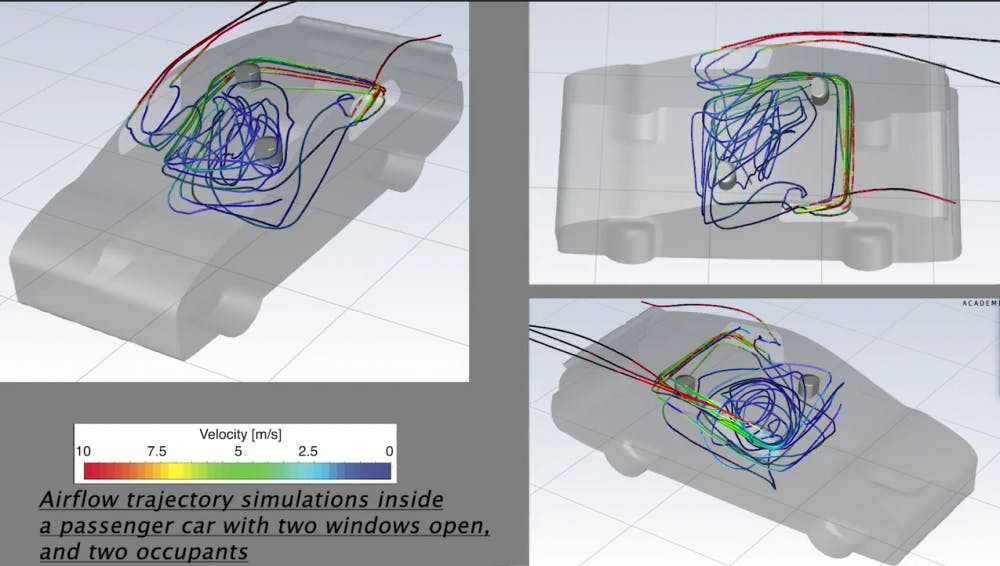By studying vehicle airflow patterns, University researchers showed that opening windows opposite the side where a person is sitting in a car can help passengers reduce COVID-19 transmission.
The study, published in early January, aims to fill a current gap in the understanding of the passenger car, which presents a challenge in preventing the spread of COVID-19 due to its small indoor environment.
“You cannot maintain six feet inside a car, and the ventilation in cars is not designed to prevent spread,” said Varghese Mathai, former postdoctoral researcher at the University and current assistant professor at the University of Massachusetts Amherst.
Mathai, a joint first author of the study, explained that the data provides a better understanding of airflow in passenger cars.
“There’s not a lot of literature about air quality in single family cars and infectious diseases,” said L. James Lo, assistant professor of architectural and environmental engineering at Drexel University, who was not involved in the study. This is partly because traveling in another person’s car was not as common until about five years ago when companies such as Uber became popular, he added.
Associate Professor of Pathology and Laboratory Medicine at Alpert Medical School and practicing physician at Miriam and Rhode Island Hospitals Jeffrey Bailey was inspired to begin the study when he noticed many people were driving with their windows up on a rainy day during the pandemic. “I noticed the people driving were sitting in very confined spaces. I then thought about (COVID-19) transmission,” Bailey said. The idea to study COVID-19 transmission in cars soon made its way to the engineering department in the University’s signature interdisciplinary collaborative nature, he added.
“It’s very intuitive that an open window will result in less transmission as air can flush particles outside,” said Asimanshu Das GS, a joint first author of the study.
Less intuitive was deciding where passengers should sit to reduce contamination and what configuration of open windows works best to prevent the spread of particles, Das added. The researchers hoped computer simulations would shed light on these unanswered questions.
They decided to use Computational Fluid Dynamic computer simulations to understand the particle spread and air flow through the car. The simulations involved a digitally modeled car moving at 50 miles an hour with one driver in the front left seat and one passenger in the back right seat.
CFD simulations are “definitely useful for studies” on COVID-19 and would provide a better understanding of how the virus particles spread, said Professor of Civil and Environmental Engineering at Clarkson University Andrea Ferro, who is not associated with the study.
The CFD simulations showed that a greater number of open windows resulted in more air circulation through the car, which “was not unexpected,” said Professor of Engineering Kenneth Breuer. But the specific configuration of the open windows also made a difference.
Drivers and passengers may decide to open their respective adjacent windows to try to limit the transmission of COVID-19. But the findings show that when only two windows are open, opening windows at the seat opposite each person is the best configuration to limit infectious disease spread, Das said. In the case of the simulation, this ideal configuration was when the rear left and front right windows were open, he added.
Physics principles account for this optimal configuration. The front of a car with faster airflow has lower pressure. This creates an “air curtain” that helps prevent the spread of tiny aerosol particles that are released when people breathe and talk, Mathai said.
The researchers obtained qualitative confirmation of findings from their computer simulations through additional small-scale experiments, such as trials performed using their own vehicles.
They hope their findings will inform the safety protocols the general public will take while traveling in cars. In addition to current COVID-19 recommendations, such as wearing a mask, the researchers recommend that “if you need to rideshare, open a window and ask the driver to open windows,” Mathai said. Even opening windows halfway or intermittently will help.

Jared is a Senior Staff Writer for Science and Research. He is a senior from Albuquerque, New Mexico studying physiology and biotechnology. Outside of The Herald he likes to fish, ride bikes and research the role of metals in human health and disease.





